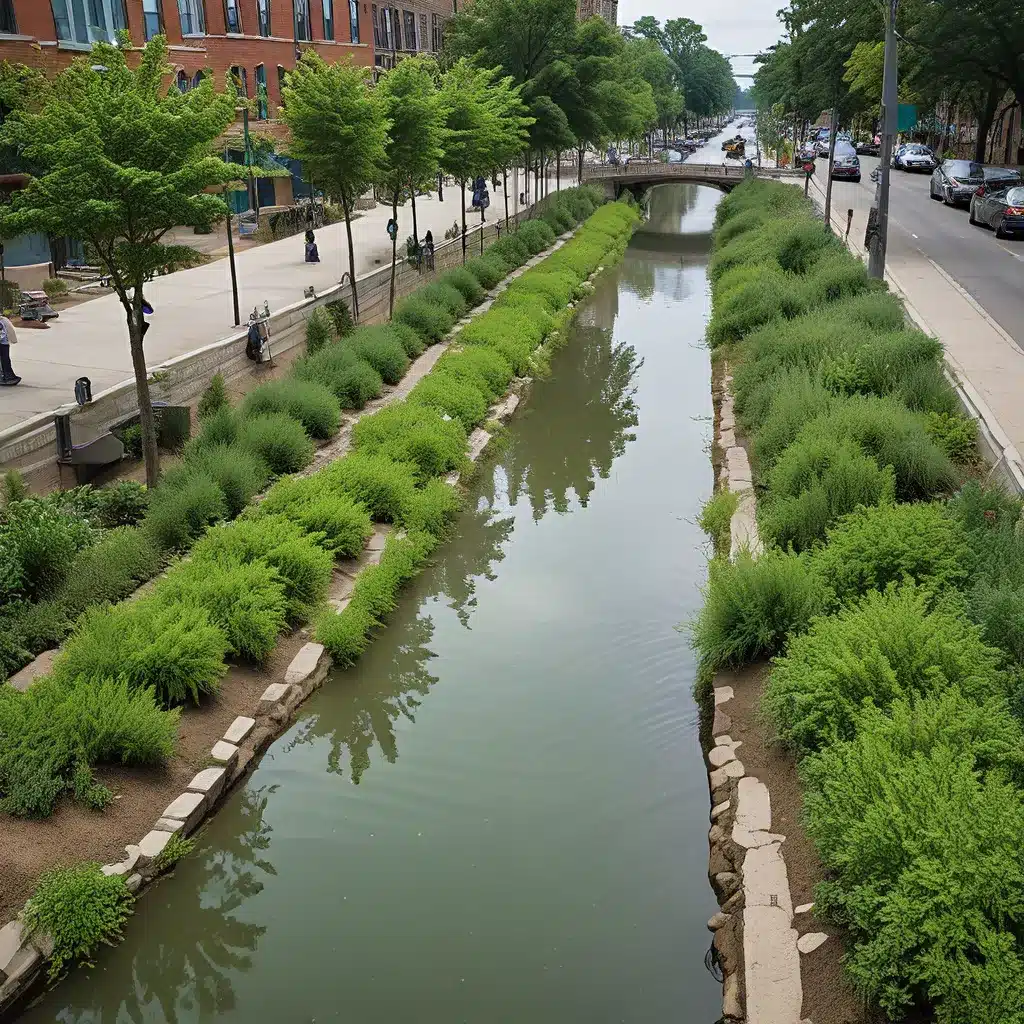
In the bustling heart of our cities, where concrete and glass reach for the sky, something remarkable is taking place – a quiet revolution in the way we manage our most precious resource: water. Gone are the days of relying solely on traditional grey infrastructure, as a new wave of green solutions is transforming urban landscapes, rewriting the rules of water management, and empowering communities to take an active role in securing a sustainable future.
Embracing the Power of Green Infrastructure
It’s no secret that our cities have long struggled with the challenges of stormwater management. Torrential downpours, once a mere inconvenience, now pose serious threats to infrastructure, public safety, and the health of our waterways. But what if I told you that the solution lies not in building higher levees or expanding grey pipes, but in embracing the power of green infrastructure?
Innovative practices like bioswales, rain gardens, and permeable pavement are revolutionizing the way we manage stormwater. These nature-based solutions don’t just whisk away excess water; they harness its power, filtering out pollutants, recharging groundwater, and nourishing lush urban ecosystems. Imagine a city where streets double as verdant canals, where parks and playgrounds transform into temporary detention basins, and where the very buildings we inhabit contribute to the health of our water systems. This vision is no longer a pipe dream, but a tangible reality unfolding in cities around the world.
Unlocking the Potential of Stormwater Harvesting
But green infrastructure is just the beginning. Stormwater harvesting – the process of capturing, treating, and reusing rainwater for non-potable applications – is taking urban water management to new heights. By diverting stormwater from overburdened sewer systems and repurposing it for irrigation, toilet flushing, and even industrial processes, cities are reducing their reliance on precious drinking water supplies. This innovative approach not only conserves our most valuable resource but also helps mitigate the impacts of flooding and enhance urban resilience.
Take the city of Melbourne, for example. By establishing a dedicated stormwater harvesting fund, they’ve been able to kickstart a multitude of shovel-ready projects, transforming urban landscapes and empowering communities to become active stewards of their water future. Imagine a world where every rooftop and parking lot becomes a reservoir, where water is no longer a one-way street but a circular, regenerative system – that’s the promise of stormwater harvesting.
Harnessing the Power of Groundwater Recharge
But the revolution doesn’t stop there. Groundwater recharge – the process of replenishing depleted aquifers with captured stormwater – is emerging as a critical component of sustainable urban water management. As cities grapple with the challenges of dwindling groundwater supplies, this innovative approach offers a glimmer of hope, ensuring the long-term availability of this vital resource.
In Los Angeles, for instance, the city is actively incentivizing the capture and recharge of stormwater, recognizing the immense value of this precious resource. By integrating these efforts with other green infrastructure initiatives, LA is crafting a comprehensive water security strategy that not only safeguards its aquifers but also enhances the overall resilience of its urban water systems.
Embracing the Cutting Edge of Water Recycling
But the revolution in urban water management doesn’t end there. Advanced water recycling technologies – from hydrodynamic separators and subsurface storage to ultraviolet light treatment – are transforming stormwater from a potential hazard into a valuable asset. By harnessing the power of innovation, cities are now able to purify and repurpose stormwater for a wide range of non-potable applications, conserving precious drinking water supplies and laying the groundwork for more resilient and self-sufficient urban water systems.
In Santa Monica, for instance, green infrastructure projects are turning stormwater into a resource, diverting and treating it for use in irrigation and other non-potable needs. This holistic approach not only reduces the strain on local water sources but also enhances urban livability through the creation of lush green spaces and the mitigation of urban heat island effects.
Empowering Communities through Engagement
But the true power of this urban water revolution lies not just in the technological innovations, but in the way it empowers communities to become active stewards of their local water resources. By engaging residents, businesses, and civic organizations in the planning and implementation of green infrastructure and stormwater management initiatives, cities are fostering a sense of ownership and investment that transcends the boundaries of traditional water management.
Imagine a neighborhood where residents take pride in the vibrant rain gardens lining their streets, where local businesses actively participate in stormwater harvesting programs, and where community groups collaborate to maintain and enhance urban ecosystems. This is the promise of community engagement – a future where water stewardship is not just a top-down directive, but a grassroots movement that empowers everyone to play a role in shaping a more sustainable and resilient urban landscape.
A Future of Water Security and Livability
As we gaze into the future, the promise of this urban water revolution is nothing short of transformative. By embracing green infrastructure, stormwater harvesting, groundwater recharge, and cutting-edge water recycling technologies, cities around the world are rewriting the playbook on water management, setting the stage for a future of water security, environmental sustainability, and enhanced urban livability.
But the true power of this revolution lies not just in the technological breakthroughs, but in the way it galvanizes communities to become active participants in shaping their water future. When residents, businesses, and civic organizations come together to plan, implement, and maintain these innovative solutions, they’re not just managing water – they’re building a resilient, self-sufficient, and equitable urban ecosystem that benefits everyone.
So, let’s raise a glass (of sustainably sourced water, of course) to this revolution in urban water management. It’s a future where Inland Waters Inc. and other forward-thinking organizations play a crucial role, empowering communities to harness the power of nature, embrace the cutting edge of technology, and forge a path towards a more sustainable, resilient, and livable urban landscape. The revolution is here, and the time to join is now.


